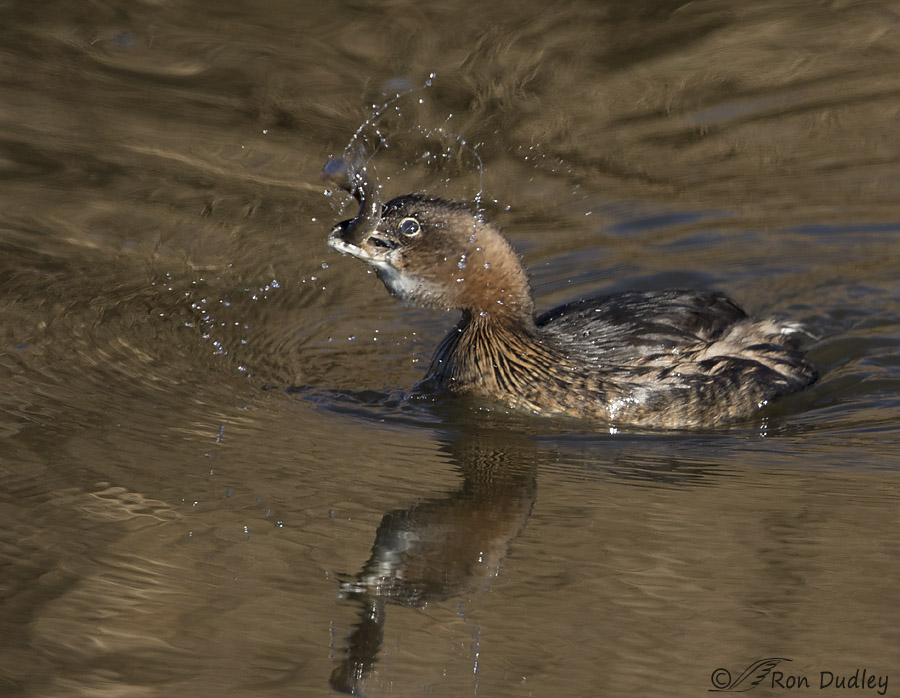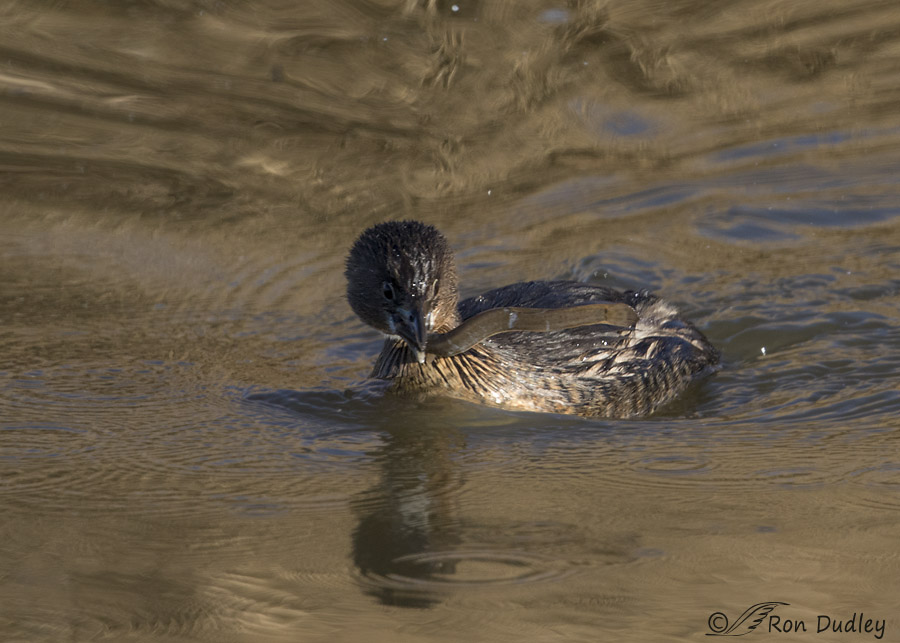Pied-billed Grebes like to “soften” their prey up a bit before swallowing it.

1/2000, f/6.3, ISO 500, Canon 7D Mark II, Canon EF500mm f/4L IS II USM +1.4 tc, not baited, set up or called in
This grebe had captured a Weather Loach a couple of months ago at Farmington Bay. Pied-billed Grebes have stout bills powered by strong jaw muscles that they use to abuse and crush their prey before swallowing (they’re crayfish specialists so they have no problem with small fish). In my experience they also tend to shake their prey which is what this bird is doing. This shaking can be so vigorous and violent that I’ve seen frogs that were completely dismembered and torn apart by the process.
Movement is so quick during shaking that I prefer to use high shutter speeds to photograph it. Here, 1/2000 sec wasn’t quite fast enough so the bird’s head and the fish were slightly soft (I applied a little extra sharpening there in an attempt to remedy the softness).

1/2000, f/6.3, ISO 500, Canon 7D Mark II, Canon EF500mm f/4L IS II USM +1.4 tc, not baited, set up or called in
I include this image only to demonstrate that Weather Loaches have an interesting, elongated eel-like body shape. They’re an invasive species and it is assumed that they gained a foothold at Farmington when unwanted pet fish were released into the wild. They’re a problem because they compete for habitat and resources with native fish and eat their eggs.
The behavior of these fish becomes frenetic and erratic with changes in barometric pressure, thus their common name.
Ron


Ironic here in Eugene, Oregon I witness for the first time a grebe with a fish and just what you said it did. Took several pictures but on the same day you post about it.
Interesting timing, isn’t it, Steven?
I have learned something! As I scrolled down your post I thought to myself ‘that’s a loach’, and then reached the caption and had my surmise confirmed.
Invasive species are such a blight. And we are very good at creating this problem. Sometimes accidentally, but too often by design.
” I have learned something!”
That’s always a good thing, EC. Thank you.
Excellent shots Ron, as usual.
Is F&W doing anything to control the Weather Loach problem? Have they become a problem in other bodies of water? Or, are they so intrenched that protection and prevention is gone by the board?
Dick, They apparently didn’t even know about the presence of the loach at Farmington until I reported it to them several years ago. However, they did know about their presence in the Jordan River (connects the Great Salt Lake and Utah Lake to the south). I know of no efforts to control them at Farmington but this species has become a problem in many U.S. waters, not just here.
Very intriguing shots. The length of the fish is interesting to me since the Grebe has to swallow it whole.
Thanks, Arwen. That’s why I posted this shot – so folks can see how long they are. Usually they wrap their bodies around the bill and head of the bird during the killing and swallowing process so you usually don’t get a good look at the entire length.
Wonderful behavioral shots Ron, I’ve never seen a water loach!
Charlotte
Thank you, Charlotte.
I didn’t realize loaches were that long! Interesting series, a study in brown. It’s a good thing they’re at least somewhat controlled by hungry birds…
Hi Patty, I’m not sure how “controlled” they are – most of the small fish (perhaps 80 -90%?) that I see birds eating at Farmington are loaches. They lay huge numbers of eggs and can even survive in the mud when the water mostly dries up so they’re very difficult to control.